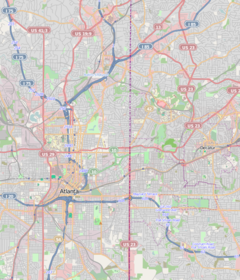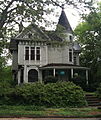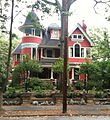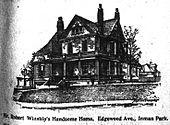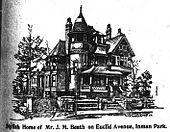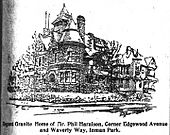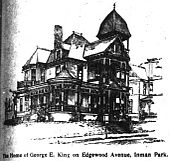- Inman Park
-
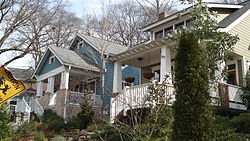
Location: Roughly bounded by Freedom Parkway, DeKalb and Lake Aves. (original) and Roughly bounded by Lake, Hurt, and DeKalb Aves., and Krog St. (increase), Atlanta, Georgia Coordinates: 33°45′20″N 84°21′34″W / 33.75556°N 84.35944°WCoordinates: 33°45′20″N 84°21′34″W / 33.75556°N 84.35944°W Built: 1889 Architect: Multiple Architectural style: Colonial Revival, Queen Anne, Shingle Style (original); Queen Anne, Stick/Eastlake, et al. (increase) Governing body: Private NRHP Reference#: 73000621 and 01000973[2] Added to NRHP: July 23, 1973 (original)
September 16, 2001 (increase)Inman Park is a neighborhood of the city of Atlanta, Georgia, and its first planned suburb. It was named for Samuel M. Inman.
Contents
Architecture
Inman Park contains Atlanta's best collection of residential architecture from the late 19th and early 20th centuries. Styles include Queen Anne, high-style Italianate and Romanesque mansion as well as smaller bungalows, shotguns, and foursquares. Inman Park was Atlanta's first example of a garden suburb, with great attention paid to street layout, parks and other public space, and would inspire other Atlanta garden suburbs such as the Frederick Law Olmsted-designed Druid Hills.
There are two historic districts within the Inman Park neighborhoods: the Inman Park historic district, and the Inman Park-Moreland Historic District, originally the separate suburb of Moreland Park.[3]
History
Today's neighborhood of Inman Park includes areas that were originally considered:
- Inman Park proper (today the Inman Park Historic District)
- Moreland Park (today the Inman Park-Moreland Historic District)
- Industrial areas on the western side, now Inman Park Village
The area was part of the battlefield in the Battle of Atlanta in 1864.
Atlanta's first streetcar suburb
Inman Park (proper) was planned in the late 1880s by Joel Hurt, a civil engineer and real-estate developer who intended to create a rural oasis connected to the city by the first of Atlanta's electric streetcar lines. The East Atlanta Land Company acquired and developed more than 130 acres east of the city and Hurt named the new suburb for his friend and business associate, Samuel M. Inman. Joseph Forsyth Johnson was hired as landscape designer for Inman Park who included curvilinear street designs and liberal usage of open spaces in his planning.[4][5][6]
The Atlanta Constitution in 1896 grandly described Inman Park:
"High up above the city, where the purest breezes and the brightest sunshine drove away the germs of disease, and where nature had lavished her best gifts, the gentlemen who conceived the though of Inman Park found the locality above all others which they desired. It was to be a place of homes, of pretty homes, green lawns, and desirable inhabitants. And all save those who would make desirable residents have been excluded..." "It's the prettiest, highest, healthiest and most desirable locality I ever saw. Everybody is friendly and neighborly. There are no negroes and not a single objectionable inhabitant. And as far as accessibility it ranks second to no residence portion of the city. We have three car lines and frequent schedules."[7]
Moreland Park was by contrast developed as a more traditional, incremental building of sub-divisions as opposed to the grand plan for Inman Park proper.
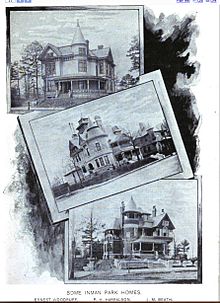 Sketches of three Inman Park houses, 1895; Ernest Woodruff's house at top; Beath-Dickey House at bottom
Sketches of three Inman Park houses, 1895; Ernest Woodruff's house at top; Beath-Dickey House at bottom
Decline
The arrival of the automobile allowed upper class Atlantans to live in suburbs farther north from downtown workplaces, such as Morningside and what is now considered Buckhead. Inman Park became less fashionable and the exuberant Victorian architecture came to seem dated. The mansions came to be subdivided into apartments.
Similar to other intown neighborhoods such as Virginia Highland, Inman Park fell to blight during the white middle and upper class exodus to the northern suburbs in the 1950s and 1960s, and was:
"an economically depressed neighborhood of mostly blue-collar white folks, elderly couples who could not afford to move out and families on disability and welfare. They lived in rented bungalows or big houses chopped up into tiny roach-infested apartments."[8]
Atlanta's first intown neighborhood to gentrify
Gentrification began in 1969 with the renovation of the Beath-Dickey House by Bob Griggs and his partner Robert Aiken.
Freeway revolt against I-485
Main article: Freeway revolt in AtlantaDuring this same period, there was an intense fight against the I-485 freeway which was to be built through the neighborhood, although many properties in Inman Park, as well as the entire neighboring neighborhood of Copenhill, were torn down in preparation for freeway construction.
Inman Park today
After decades of restoration and renewal, Inman Park is now a highly coveted intown neighborhood with numerous million-dollar properties.
Former industrial areas on the west side of the neighborhood - notably the sites of the former General Pipe and Foundry complex and the Mead paper plant, have been redeveloped and are home to both new and repurposed condo and apartment developments, restaurants and other businesses.
Education
Residents in Inman Park are within Atlanta Public Schools.
Zoned schools include:
- Mary Lin Elementary School (located in nearby Candler Park)
- Inman Middle School
- Henry W. Grady High School
References
- ^ The original NRHP listing was as "Inman Park" but the boundary increase renamed it to "Inman Park Historic District" in the NRHP.
- ^ "National Register Information System". National Register of Historic Places. National Park Service. 2009-03-13. http://nrhp.focus.nps.gov/natreg/docs/All_Data.html.
- ^ National Register of Historic Places
- ^ Bazemore, Ted (9/12/2007). "Inman Park". The New Georgia Encyclopedia. http://www.georgiaencyclopedia.org/nge/Article.jsp?id=h-3483. Retrieved 27 December 2010.
- ^ "Bruce Forsyth". Who do you think you are?. BBC. http://www.bbc.co.uk/programmes/b00t6gbb. Retrieved 28 December 2010.
- ^ Joseph Forsyth Johnson was the author of The Natural Principles of Landscape Gardening; or, The adornment of land for perpetual beauty. Belfast: Archer, 1874
- ^ "Homes at the Park: Beautiful residences that make Inman Park an ideal home place", Atlanta Consitution, 1896-03-26
- ^ "Road Rage: If you enjoy downtown's green spaces, thank the intown voters of 1972", Atlanta Magazine, October 2005
External links
- Inman Park Neighborhood Association
- Atlanta City Council resolution (2002) to expand the historic district, contains detailed information about Inman Park history and architecture
- New Georgia Encyclopedia
- Sketches of prominent Inman Park homes, 1895
- Atlanta, Georgia, a National Park Service Discover Our Shared Heritage Travel Itinerary
People Asa Griggs Candler - Phil Haralson - Joel Hurt - Samuel M. Inman - Joseph Forsyth Johnson - George Edward King - Robert Winship - Ernest WoodruffPlaces Beath-Dickey House - Copenhill - Dad's Garage Theatre Company - Freedom Park - General Pipe and Foundry Company - Inman Park-Moreland Historic District - Kriegshaber House (Wrecking Ball Brewpub) - Little Five PointsTransportation Atlanta & Edgewood Street Railroad - Freedom Parkway - Inman Park/Reynoldstown MARTA station - I-485 (proposed freeway through Inman Park) - Streetcars in AtlantaDruid Hills · Midtown · Morningside-Lenox Park · Old Fourth Ward · Poncey-Highland · Virginia-Highland · All neighborhoods of AtlantaNeighborhoods of Atlanta, Georgia
Downtown Castleberry Hill - Fairlie-Poplar - Centennial Hill - Hotel District - Five Points - Luckie Marietta - Peachtree Center - SoNo - South DowntownMidtown Ansley Park - Atlantic Station - Colony Square - Fox Theatre Historic District - Historic Midtown - Home Park - Sherwood Forest - Technology SquareBuckhead Brookwood Hills - Buckhead Forest - Buckhead Village - Garden Hills - Historic Brookhaven - Lindbergh - Margaret Mitchell - North Buckhead - Paces - Peachtree Hills - Peachtree Park - Pine Hills - TerminusWest Midtown Blandtown - Home Park - Knight Park-Howell Station - Loring Heights - Marietta Street Artery - Underwood Hills - Westside ProvisionsEast Atkins Park - Cabbagetown - Candler Park - Druid Hills - East Atlanta - East Lake - Edgewood - Glenwood Park - Grant Park - Inman Park - Kirkwood - Lake Claire - Lindridge/Martin Manor - Little Five Points - Morningside/Lenox Park - North Ormewood Park - Oakland - Old Fourth Ward - Ormewood Park - Piedmont Heights - Poncey-Highland - Reynoldstown - Sweet Auburn - Villages of East Lake - Virginia HighlandSouth Benteen Park - Capitol Gateway - Chosewood Park - Joyland - Lakewood Heights - South Atlanta - Summerhill - Villages at CarverSouthwest Adair Park - Adamsville - Ben Hill - Capitol View - Capitol View Manor - Cascade Heights - Collier Heights - Just Us - Mechanicsville - Oakland City - Perkerson - Peoplestown - Pittsburgh - Sylvan Hills - Villages of Castleberry Hill - West End - WestviewNorthwest Bankhead - The Bluff - Center Hill - English Avenue - Grove Park - Hunter Hills - Mozley Park - Riverside - Vine City - Washington Park - West Highlands - West Lake - Whittier Mill Village
Beaver Slide - Bedford Pine - Bellwood - Brownsville - Buttermilk Bottom - Copenhill - Darktown - Easton - Hemphill Avenue - Jackson Row - Johnstown - Lightning - Macedonia Park - Moreland Park - Murrell's Row - Plunkett Town - Shermantown - Slabtown - Standing Peachtree - Tanyard BottomU.S. National Register of Historic Places Topics Lists by states Alabama • Alaska • Arizona • Arkansas • California • Colorado • Connecticut • Delaware • Florida • Georgia • Hawaii • Idaho • Illinois • Indiana • Iowa • Kansas • Kentucky • Louisiana • Maine • Maryland • Massachusetts • Michigan • Minnesota • Mississippi • Missouri • Montana • Nebraska • Nevada • New Hampshire • New Jersey • New Mexico • New York • North Carolina • North Dakota • Ohio • Oklahoma • Oregon • Pennsylvania • Rhode Island • South Carolina • South Dakota • Tennessee • Texas • Utah • Vermont • Virginia • Washington • West Virginia • Wisconsin • WyomingLists by territories Lists by associated states Other Historic Districts in Metro Atlanta Clayton County 
Cobb County Coweta County Grantville · Newnan: Cole Town · Greenville St.-LaGrange St. · Newnan Commercial · Newnan Cotton Mill and Mill Village · Northwest Newnan Residential · Platinum Point · Roscoe: Roscoe-Dunaway Gardens · Sargent · SenoiaDeKalb County Atlanta: Candler Park · Druid Hills · Inman Park-Moreland · Kirkwood · Avondale Estates · Brookhaven: · Oglethorpe University · Decatur: South Candler Street-Agnes Scott College ·Winnona Park · Druid Hills: Emory Grove · Emory University District · University Park-Emory Highlands-Emory Estate · Stone MountainDouglas County Fulton County Atlanta: Adair Park · Ansley Park · Atkins Park · Atlanta University Center · Berkeley Park · Brookhaven · Brookwood Hills · Cabbagetown · Castleberry Hill · Collier Heights · Druid Hills · Fairlie-Poplar · Fox Theatre Historic District · Garden Hills · Georgia Tech · Grant Park · Hotel Row · Howell Interlocking · Knight Park-Howell Station · Inman Park · Inman Park-Moreland · Knox Apts., Cauthorn House and Peachtree Rd. Apts. · Lakewood Heights · Martin Luther King, Jr., National Historic Site · Means St. · Midtown · Mozley Park · Oakland City · Peachtree Highlands-Peachtree Park · Pittsburgh · Reynoldstown · Southern Ry. North Ave. Yards · Sunset Ave. (proposed) · Sweet Auburn · Techwood Homes · Underground Atlanta · Virginia Highland · Washington Park · West End · Whittier Mills
College Park · East Point: Industrial District · Fairburn · Hapeville · RoswellGwinnett County Hall County Clermont · Flowery Branch · Gainesville: · Brenau College · Chicopee Mill and Village · Gainesville Commercial · Green Street · Green St.-Brenau · Gillsville · LulaNewton County Covington · Covington Mills and Mill Village · Floyd Street · Newborn · North Covington · Oxford · Porterdale · StarrsvilleRockdale County Categories:- Neighborhoods in Atlanta, Georgia
- Historic districts in Metro Atlanta
- Streetcar suburbs
- Queen Anne architecture in Georgia (U.S. state)
- Shingle Style architecture
- Colonial Revival architecture in Georgia (U.S. state)
- Buildings and structures completed in 1889
Wikimedia Foundation. 2010.

